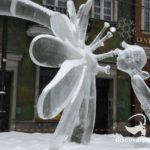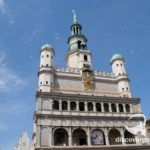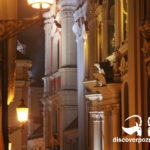Welcome to Poland, welcome to our city! Professionally guided tours of Poznań are waiting for you! If you would like to learn either important or trivial, funny or tragic, but always carefully selected stories to match your group members’ age and interests – do get in touch! One city may have many different faces – depending on the viewing angle you assume, you may experience very different worlds walking down one and the same street. Allow me to accompany you on that journey and make your experience of Poznan a truly unforgettable one. Here you will find the description of some "must see" attractions.
Poznań
Poznań is one of the oldest and largest cities in Poland, where history meets modernity. On Poznan’s Cathedral Island PopeJohn Paul II famously stated that in this very place the Polish state and the history of Polish Church begun over 1000 years ago.
It is here where the first historical ruler of Poland Mieszko I built his palace. In 1253, two and a half centuries later, on the opposite river bank, a new dynamic city started to grow. Today it counts about 500 000 inhabitants and ranks fifth in Poland in terms of population and economy. The city’s character is influenced by a large number of students – over 130 000 young Poles study here, at eight state and over twenty private universities and colleges. It is also an important outsourcing and offshoring hub.
The distinguished Basilica of Saint Peter and Saint Paul overlooks the old Prussian fortifications located alongside the Cybina River, on which an artificial Malta Lake has been formed in close proximity to the Cathedral Island. Today, the lake houses one of the most modern regatta courses in Europe, used for both rowing and kayaking. There are many attractions alongside the lake, such as an artificial ski slope, a bobsleigh run, thermal and olympic swimming pools, a zoological garden and a narrow-gauge railway ride. It is also here that the world famous Malta Open Air Theatre Festival originated.
The Basilica also overlooks the Warta River. When looking in this direction, one can see the Poznań Old Town, with a jewel of Polish Renaissance – the 16th century town hall, where the famous billy goats appear at noon every day.
Further behind you can see a tower of the royal castle. It is here that in 13th century king Przemysł II established the white eagle as the national emblem of Poland.
The royal castle is not the only castle in the city. In the beginnings of the 20th century another one – the Imperial Castle – was built here for the Prussian emperor. Today it is considered the youngest great royal residence in Europe.
It is at the castle’s very doorstep, on Adam Mickiewicz Square, that the first rebellion against communism took place on June 28th, 1956.
Poznań is also a city of culture and music. Many great and famous choirs originate in Poznań. Also the Henryk Wieniawski Violin and Violinmaking World Competition is held here every 5 years. In Fara (the main parish church) – a pearl of baroque architecture – one can find one of the two best organs in Poland. The instrument was made by the famous 20th century constructor Friedrich Ladegast.
The city stadium, which was one of the host stadiums for Euro 2012 games, can accommodate over 42 thousand spectators. Stary Browar (The Old Brewery) has twice been awarded the international prize for the best shopping centre in the world. These are just two examples of the city modern architecture.
Poznań also ranks very high in terms of economy. It is here, that the largest in Poland number of small and medium enterprises is registered. It is also home to some big ones, such as: Allegro.pl, Volkswagen, Man, GSK, Wyborowa SA, Wrigley, Goplana or Terravita. The last three of the aforementioned manufacture popular sweets of different varieties. But one cannot say they have tasted Poland unless they try Rogal Świętomarciński (St Martin’s Croissant). You can buy rogals in coffee shops and confectioneries. Enjoy!
If you wish to learn more about the city’s attractions, we invite you to one of our professionally guided, fascinating tours.
Old Market Square
The City of Poznań was born on today’s Cathedral Island, located between the branches of Warta and Cybina rivers. As the centuries passed, generations of Poles grew up on the Island. In 1253 prince Przemysł I resolved to revive this secluded piece of land, inaccessible and surrounded by swamps, where life was arduous and opportunities few, and he founded a new city on the left river bank. Grounds were exchanged with the archbishop to achieve this.
The new city was surrounded by high walls and had four main gates. Atop the Przemysł Hill, a castle was built. It was in this castle that king Przemysł II established the white eagle as the national emblem of the Kingdom of Poland. Many important marriages were contracted here and one of the historic homages of the Teutonic Knights was paid on the Przemysł Hill.
At the centre of the fortified city was a Market Square; which to this day remains the third largest in Poland. Poznań has a long mercantile history – it was founded under Magdeburg Law and some of the most important trade routes crossed here. Due to Poznan’s unique position king Władysław Jagiełło granted the town in 1394 the ‘storage law’, which meant that all the merchants passing through it were obliged to stop for some time and engage in trade. As a result, the city began to thrive and quickly grew in wealth and splendour. It is doubtlessly to these early circumstances that Poznan and its inhabitants owe their reputation as particularly enterprising and resourceful, and the events and decisions of that period shaped Poznan’s future for centuries to come.
The town hall, rebuilt after the great fire of 1535, is today considered a pearl od Polish Renaissance architecture. Every day at noon one can watch Poznan’s famous billy goats butt their heads atop the old town’s clock tower.
At its southern wall there is a line of narrow and distinctly coloured historic townhouses, which make for a unique and very picturesque scene. In yet earlier times, the square was occupied by equally vibrant and colourful merchant stalls, were freshly baked bread, meat, fish, leather goods and woolen cloths were sold. On one of the houses the insignia of the fraternity of those merchants can still be seen. The square is bordered by houses from different centuries, some of them could tell very interesting stories – of a merchant turned into a wolf, a private palace with a rooftop goldfish pond, a piece of roof that saved a king’s life…
In the four corners of the square stand four fountains – once simple horse-watering wells, now richly decorated, with classic statues of mythical gods: Pluto kidnapping Proserpina (the only one dating back to 18th century), Apollo, Neptune and Mars. Another small fountain has become one of the symbols of the city – the Bamberka, located at the back of the town hall, is a woman dressed in a traditional folk dress and holding two water jugs. Her story is linked to the German settlers who came to the area in 18th century. The Old Market Square still holds many secrets, waiting to be discovered…
Town Hall and it’s billy goats
The first mention of Poznan town hall dates back to 1310. Some artefacts from that period remain to this day in its cellars. In this building the City Council gathered to establish new laws or to dispute important issues relating to the administration and management of the city. In 1536 a great fire nearly consumed the whole borough of Przemysł. Some years later a talented architect Jovanni Baptista Quadro arrived in Poznań and in 1550 started the construction of the new town hall. He drew up a completely new design, including an elegant and fashionable, east-facing façade, with three Italian-style loggia, topped with battlements resembling city walls. The Poznan town hall is now considered a pearl of Polish Renaissance architecture.
Each day as the tower clock strikes noon, two billy goats appear above the clock, butting their heads twelve times, to the delight of a curious crowd of children and travellers gathered below. How did they become one of the city’s most recognisable symbols? The legend has it, that there was a great feast organized for the opening of the new tower. A kitchen boy was tasked with attending to the main course – a venison roast – but overcome by curiosity of the festivities outside, he left the roast unattended and so it charred completely. The petrified boy, in an attempt to make up for his failure, stole a couple of small goats from a nearby pasture, and intended to roast them instead. The goats managed to escape the boy and ran into the tower where, trapped on its highest level and frightened for their lives, started butting their heads in confusion, to the bewilderment and amusement of the revellers gathered in the square below. In 1561 Bartholomew Wolf of Gubin made a tower clock for the town, and in it incorporated a mechanism with two head-butting billy goats. The original was man-powered!
Passers by are watched from the walls of the town hall by the kings and rulers of the Piast and Jagiellon dynasties. The coat of arms of Stanislaus Augustus Rex underneath the clock commemorates the last Polish king. Another decoration contains symbolic guidelines and suggestions for the city fathers. At the top of the building one can observe a mysterious three-faced creature…
The inside of the town hall also hides many unusual features. There is a Gothic Entryway with numerous painted shields and trophies of Rooster Marksman Fraternities, the history of Merchant Associations room, the Kings Room with portraits of Polish monarchs, the Court Room with its most spectacular interiors; the Great Renaissance Hall with magnificent and rich symbolical, astrological and mythological decorations on its ceilings.
After World War II the seat of the local government was moved to the buildings of the former Jesuit College, while the town hall now houses the Museum of the History of Poznań.
Jesuits in Poznań – The Poznan Collegiate Church of Saint Mary’s Magdalain and Saint Stanislav (Fara)
The Jesuits arrived to Poznań in about 1570 and soon started to rebuild St. Stanislav’s church. They also established a college that later became famous for being one of the best high schools in Poland.
To construct the school buildings (the first one was very small) and the new, bigger church, the Jesuits were forced to move the city walls, as there was not enough space inside the original ones.
After this had been completed – the construction was led by Italian architect Tom Poncino. He, however, ignored the fact, that his task was to raise a huge, heavy building on swamps (because of the neighbourhood of the city moat, which was, in fact, one of the branches of the Warta River). Newly constructed walls begun to crack, and Poncino was sent back to Italy. The works were continued by Jesuit architects and the successive rectors of the College: Natanael Wąsowski and Peter Abramowicz. The next Italian artist appeared at the construction site just before year 1700. John Catenazzi finished and gave the final make-up to the Jesuits’ work. The other names linked to the Baroque church are: Pompeo Ferrari, Carl Dankwert, Alberto Bianco.Other famous people related to the college itself were Jacob Wujek, first rector of the school and the first interpreter of the Bible to polish and Józef Rogaliński, the last rector, as well as distinguished mathematician, chemist, biologist and astronomer.
After first partition of Poland and cancellation of the Jesuit Order by Prussian government, the college buildings were converted into the residence of prince Anthony Radziwiłł. In 1806 Napoleon Bonaparte stayed here for about three weeks. Nowadays the buildings of former college are the seat of the city council.
And what about the Jesuit church?
After in XVII century a fire destroyed the nearby Collegiate Church of Saint Mary’s Magdalaine and the Prussian government did not allow its reconstruction, all the dignity and the name was passed on to the nearest church – the Jesuit one. So the name of today’s temple is one of the longest in Poland and registers its whole history… Feel invited to visit The Poznan Collegiate Church of Saint Mary’s Magdalain, the Parish Church of Saint Stanislav Bishop and Martyr, Minor Basilica, the Sanctuary of Virgin Mary of Perpetual Help, The Main Parish Church of Poznań (Fara).
The rich sculpture and painting decoration, master-art of illusion and symbolism make Poznań Fara a pearl of Baroque architecture. Perfect acoustic of the interior gives the impression that everything seems to dance and move in the sound of organ music. The instrument in one of the two considered the best ones in Poland, and its constructor Friedrich Ladegast was one of the best organs’ constructors in XIX century’s Europe.
Organ music can be heard during daily during masses, and there are also free of charge concerts played every Thursday at 8 p.m and, in summer season, every day at 12:15.
And Jesuits? Yes, they came back to our city. They take care of the church of The Sacred Heart of Jesus which is also the Sanctuary of the Madonna of the Rosary by Dominikańska Street.
















